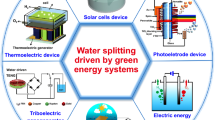Abstract
Microbial fuel cells (MFCs) generate electricity from the oxidation of dissolved organic matter. A variety of Gram-positive and Gram-negative bacteria, including Escherichia coli, produce a large quantity of indole, which functions as an extracellular signal molecule. This work explored the role of indole in a mediatorless E. coli catalyzed MFC. Although the presence of indole alone did not affect power generation, indole oxidation by the indole-oxidizing enzyme toluene-o-monooxygenase (TOM) enhanced power density by 9-fold. Open circuit voltage and polarization curve showed that indole oxidation by TOM produced a maximum power density of 5.4 mW/m2 at 1,000 ohm. Cyclic voltammetric results suggested that indole oxidation resulted in the production of redox compounds. This study provides a novel means of enhancing power generation in E. coli-catalyzed MFCs.
Similar content being viewed by others
References
Logan, B. E. (2007) Microbial fuel cells. John Wiley & Sons, Inc., Hoboken.
Lovley, D. R. (2006) Bug juice: Harvesting electricity with microorganisms. Nat. Rev. Microbiol. 4: 497–508.
Bond, D. R. and D. R. Lovley (2003) Electricity production by Geobacter sulfurreducens attached to electrodes. Appl. Environ. Microbiol. 69: 1548–1555.
Chaudhuri, S. K. and D. R. Lovley (2003) Electricity generation by direct oxidation of glucose in mediatorless microbial fuel cells. Nat. Biotechnol. 21: 1229–1232.
Newman, D. K. and R. Kolter (2000) A role for excreted quinones in extracellular electron transfer. Nature 405: 94–97.
Rabaey, K., N. Boon, M. Hofte, and W. Verstraete (2005) Microbial phenazine production enhances electron transfer in biofuel cells. Environ. Sci. Technol. 39: 3401–3408.
Park, D. H. and J. G. Zeikus (2000) Electricity generation in microbial fuel cells using neutral red as an electronophore. Appl. Environ. Microbiol. 66: 1292–1297.
Schröider, U., J. Neiâen, and F. Scholz (2003) A generation of microbial fuel cells with curretnt outputs booted by more than one order of magnitude. Angew. Chem. Int. Ed. Engl. 42: 2880–2883.
Wang, Y. F., S. Tsujimura, S. S. Cheng, and K. Kano (2007) Selfexcreted mediator from Escherichia coli K-12 for electron transfer to carbon electrodes. Appl. Microbiol. Biotechnol. 76: 1439–1446.
Zhang, T., C. Cui, S. Chen, H. Yang, and P. Shen (2008) The direct electrocatalysis of Escherichia coli through electroactivated excretion in microbial fuel cell. Electrochem. Commun. 10: 293–297.
Qiao, Y., C. M. Li, S. J. Bao, Z. Lu, and Y. Hong (2008) Direct electrochemistry and electrocatalytic mechanism of evolved Escherichia coli cells in microbial fuel cells. Chem. Commun. (Camb). 21: 1290–1292.
Lee, J. -H. and J. Lee (2010) Indole as an intercellular signal in microbial community. FEMS Microbiol. Rev. 34: 426–444.
Luo, Y., R. Zhang, G. Liu, J. Li, M. Li, and C. Zhang (2009) Electricity generation from indole and microbial community analysis in the microbial fuel cell. J. Hazard. Mater. 176: 759–764.
Rui, L., K. F. Reardon, and T. K. Wood (2005) Protein engineering of toluene ortho-monooxygenase of Burkholderiacepacia G4 for regiospecific hydroxylation of indole to form various indigoid compounds. Appl. Microbiol. Biotechnol. 66: 422–429.
Gorby, Y. A., S. Yanina, J. S. McLean, K. M. Rosso, D. Moyles, A. Dohnalkova, T. J. Beveridge, I. S. Chang, B. H. Kim, K. S. Kim, D. E. Culley, S. B. Reed, M. F. Romine, D. A. Saffarini, E. A. Hill, L. Shi, D. A. Elias, D. W. Kennedy, G. Pinchuk, K. Watanabe, S. Ishii, B. Logan, K. H. Nealson, and J. K. Fredrickson (2006) Electrically conductive bacterial nanowires produced by Shewanellaoneidensis strain MR-1 and other microorganisms. Proc. Natl. Acad. Sci. USA. 103: 11358–11363.
Blattner, F. R., G. Plunkett, C. A. Bloch, N. T. Perna, V. Burland, M. Riley, J. Collado-Vides, J. D. Glasner, C. K. Rode, G. F. Mayhew, J. Gregor, N. W. Davis, H. A. Kirkpatrick, M. A. Goeden, D. J. Rose, B. Mau, and Y. Shao (1997) The complete genome sequence of Escherichia coli K-12. Sci. 277: 1453–1474.
Han, T. H., J. H. Lee, M. H. Cho, T. K. Wood, and J. Lee (2011) Environmental factors affecting indole production in Escherichia coli. Res. Microbiol. 162: 108–116.
Lee, J., A. Jayaraman, and T. K. Wood (2007) Indole is an interspecies biofilm signal mediated by SdiA. BMC Microbiol. 7: 42.
Min, B., S. Cheng, and B. E. Logan (2005) Electricity generation using membrane and salt bridge microbial fuel cells. Water Res. 39: 1675–1686.
Watson, V. J. and B. E. Logan (2010) Power production in MFCs inoculated with Shewanellaoneidensis MR-1 or mixed cultures. Biotechnol. Bioeng. 105: 489–498.
Cheng, S. and B. E. Logan (2007) Ammonia treatment of carbon cloth anodes to enhance power generation of microbial fuel cells. Electrochem. Commun. 9: 492–496.
Franks, A. E., N. Malvankar, and K. P. Nevin (2010) Bacterial biofilms: The powerhouse of a microbial fuel cell. Biofuels. 1: 589–604.
Ren, Z., R. P. Ramasamy, S. R. Cloud-Owen, H. Yan, M. M. Mench, and J. M. Regan (2011) Time-course correlation of biofilm properties and electrochemical performance in single-chamber microbial fuel cells. Bioresour. Technol. 102: 416–421.
Zhang, T., C. Cui, S. Chen, X. Ai, H. Yang, P. Shen, and Z. Peng (2006) A novel mediatorless microbial fuel cell based on direct biocatalysis of Escherichia coli. Chem. Commun. (Camb). 11: 2257–2259.
Author information
Authors and Affiliations
Corresponding author
Rights and permissions
About this article
Cite this article
Han, T.H., Cho, M.H. & Lee, J. Indole oxidation enhances electricity production in an E. coli-catalyzed microbial fuel cell. Biotechnol Bioproc E 19, 126–131 (2014). https://doi.org/10.1007/s12257-013-0429-7
Received:
Revised:
Accepted:
Published:
Issue Date:
DOI: https://doi.org/10.1007/s12257-013-0429-7




